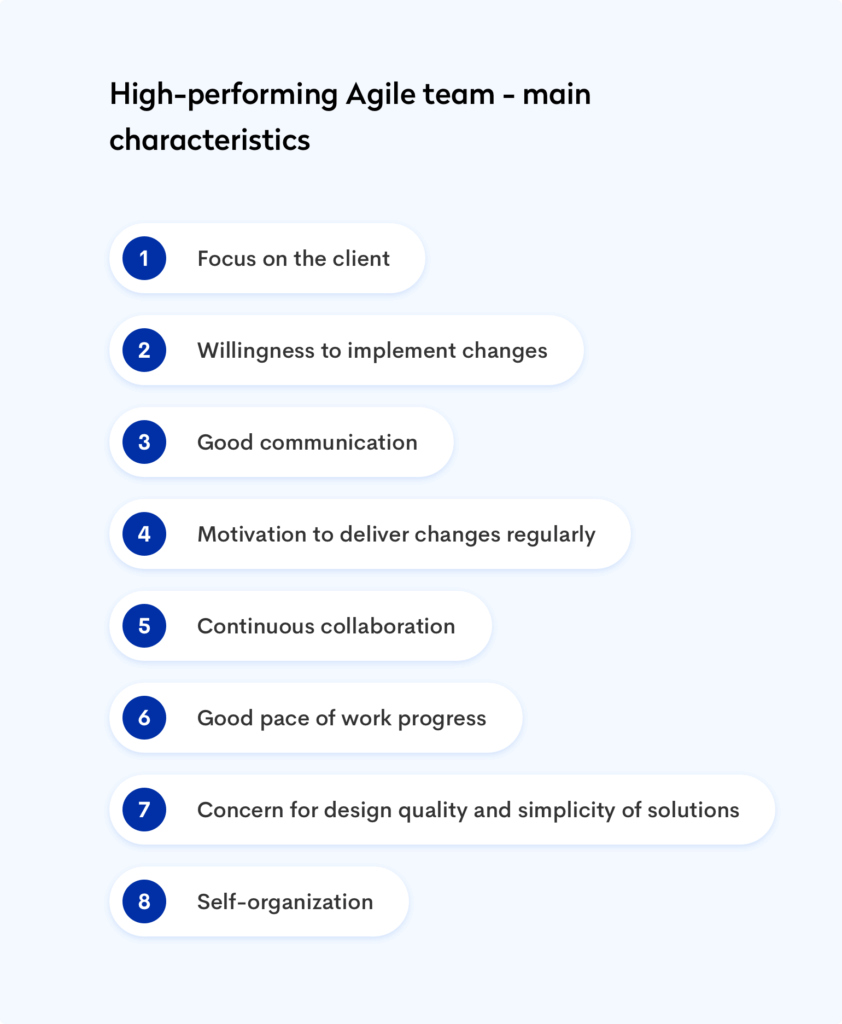Agile teams: What are their characteristics?
“Agile is about avoiding delay and delivering business value that you really need to the market as soon as possible, and that means with a high level of quality. “
Arie Van Bennecum
This quote comes from one of the authors of the Agile Manifesto, a simple-yet-powerful document outlining the main principles of Agile software development. According to its fundamental values and principles, Agile teams should deliver a working piece of software every few weeks (4-6 weeks). The significance behind this way of working is the ability to quickly verify and test the product’s features and act accordingly.
Nowadays, Agile has become an industry standard for software development companies, focused on goal-oriented work methods and quicker delivery of high-quality products. Achieving that goal is possible because of the Agile approach, which gives space for flexibility and quick adaptation.
As you can see, adopting Agile may be very beneficial for businesses, and Agile teams following core principles can achieve great results. This article will share crucial information that helps you understand how Agile product teams work in a professional environment. Additionally, we will list some characteristics of a successful Agile team. Let’s dive deeper into this topic!
Table of Contents
What does it mean to be an Agile team?
Let’s start with a short definition. An “Agile team” means a cross-functional group of experts responsible for delivering an Agile project. In most cases, they work within the Scrum principles, which define the cooperation between people performing specific roles. The approach suggested in Scrum allows quick reaction to changes and a more accurate representation of the sequence of work.
An Agile team comprises just a handful of people (in most cases, no more than 9): small enough to stay agile and big enough to successfully deliver a piece of software in a sprint. A “sprint” means a single iteration – a specific period of time needed to finish a product increment (e.g., selected functionalities). The Agile team shows an adaptive approach to the product and the entire development process in close cooperation with the client.
Among other things, the Agile team is interdisciplinary, meaning that all team members have the necessary skills to produce a valuable incremental product. According to the spirit of Agile, teams should also be self-managing: that is, able to decide who will perform specific tasks, when, and how.
Core roles in the Agile team
Now that we’ve covered what an Agile team really is, it’s time to clarify the responsibilities of each role. In practice, those roles may differ depending on the framework – for example, in Scrum, roles are well-defined, while Kanban gives room for more flexibility and industry. Here we will focus more on Scrum, where all team members are equal in their substantive contribution and can trust in their colleagues’ competencies.
There are three main roles in the Agile team:
Scrum Master
The Scrum Master ensures that the Scrum framework is followed and all the team members understand Scrum theory and practice. What’s more, the Scrum Master manages the process and the team’s effectiveness. Let’s sum up his primary accountabilities:
- Supporting the Product Owner – The Scrum Master is responsible for creating and managing the Product Backlog (making sure Backlog items are clear and concise). Additionally, he/she helps establish product planning.
- Supporting the Development Team – The Scrum Master coaches the team members in self-management and use of Agile practices and nurtures fruitful cooperation.
- Supporting the Whole Organization – The Scrum Master spreads essential information about Scrum principles, trains and leads the organization in Scrum adoption, and supports the changes within the organization.
Product Owner
The Product Owner removes barriers between stakeholders and the team. He/she connects multiple areas in the organization, communicating directly with stakeholders and Scrum teams to make the best business decisions and achieve desired project outcome. So let’s outline his accountabilities:
- Developing product goals
- Backlog management (keeping it clear, transparent, and understandable)
- Combining the interests of customers, team members, and end users.
Developers
Developers are also part of the Agile team and significantly impact product outcomes. This includes programmers, testers, designers, and anyone who brings value to the team and influences the outcome of the project.
What makes an Agile Team successful? 8 characteristics of high-performing Agile Teams
A team becomes Agile and high-performing once it gathers and applies essential knowledge about practicing Agile principles. It accepts and understands all the rules, leading to the highest efficiency and self-organization. When all the members maintain the same level of commitment and knowledge, they can easily support each other and perform better. Let’s take a broader perspective and put together all the qualities of a successful Agile team.
1. Focus on the client
An Agile workflow brings real-life benefits to the client. That means a high level of transparency and an iterative process that helps deliver a working piece of the product faster.
The team focuses on maximizing client benefit, and regular meetings give space for feedback and implementation, goal analysis, and delivering an app tailored to the PO’s vision. Agile teams know the vital role of communication and collecting feedback. They master their skills to become better every day.
2. Willingness to implement changes
As we mentioned, an Agile team is adaptive and ready to make adjustments. Team members know how to manage changes, and when it is necessary to implement them, the PO equips them with all the knowledge they need about the remaining tasks and the current purpose and direction of work.
3. Good communication
Although it is a so-called “soft” skill, effective communication between team members is one of the most basic requirements of a productive Agile team. A good team works with a Scrum Master to develop their communication skills and achieve the best possible results. The qualities that distinguish the best teams are:
- Empathy.
- The ability to build relationships based on trust and honesty.
- A high level of emotional intelligence.
Although developing such qualities can be challenging, when team members know it is necessary, they will work to improve their soft skills.
4. Motivation to deliver changes regularly
The team is more motivated when they work in short iterations in which they “deliver” specific functionalities. After each iteration, they deliver a potentially ready-to-use part of the product, so we can regularly see what impact the results of their work have on the product. This ensures that everyone has a specific goal, knows what they are supposed to do at a given stage, and is responsible for their own tasks and what the team will deliver at the end of the “increment.”
At Studio Software, our Agile teams are keen to develop adaptive skills, as evidenced by a recently held Agile workshop. What valuable things did we learn at them? You can read about it in an article discussing our collaboration with training company 202 Percent.
5. Continuous collaboration
Working in short iterations requires more collaboration with other teams and any associated business partners, giving frequent feedback, and adapting quickly to situations. Team members regularly talk to business staff to identify and address any pertinent issues.
6. Good pace of work progress
The team informs stakeholders about the progress of the work and ensures that a good pace of product development is maintained. It understands that it is a matter of maintaining a high-quality output with a good distribution of activities and work-life balance. Besides this, when the workload is well-distributed between stages, team members are much more likely to appreciate and respect their contributions to the overall project.

7. Concern for design quality and simplicity of solutions
It is said that prevention is better than cure. Similarly, it is better to avoid defects than to fix them later. This is made possible by applying the KISS (keep it simple, stupid) method and adhering to it in project planning, software building, and team functioning.
Agile team members regularly collaborate with customers and stakeholders to build only the most useful and valuable functionality for an ultimately helpful product. If it turns out that an element of a project is not beneficial to the company in the long run, it is often cheaper to abandon its development.
8. Self-organization
Self-organization is when no rigidly separated requirement or project development stage is used. Instead, the entire team works together to plan the project and modify those plans. At the beginning of a project, a self-organizing team separates the work into user stories (a form of requirement writing) and starts work with those issues that provide the most value to the customer.
Only after this does the team begin to think about the details of the next steps. This way, the team manages the project effectively and reduces the risk of chaos arising when other Agile teams take over.
Meet the Agile teams involved in our projects
When development teams are Agile, they can quickly deliver the following stages of a project. With good cooperation and self-organization, it is possible to achieve high efficiency, significantly streamline work and minimize the risk of mistakes. Such a team reacts quickly to changes by planning each job according to its needs and continuously improving.
Want to learn how Studio Software uses Agile project management methods? Talk to us, and we will be happy to share our experience and create a professional product for you based on our proven process.






